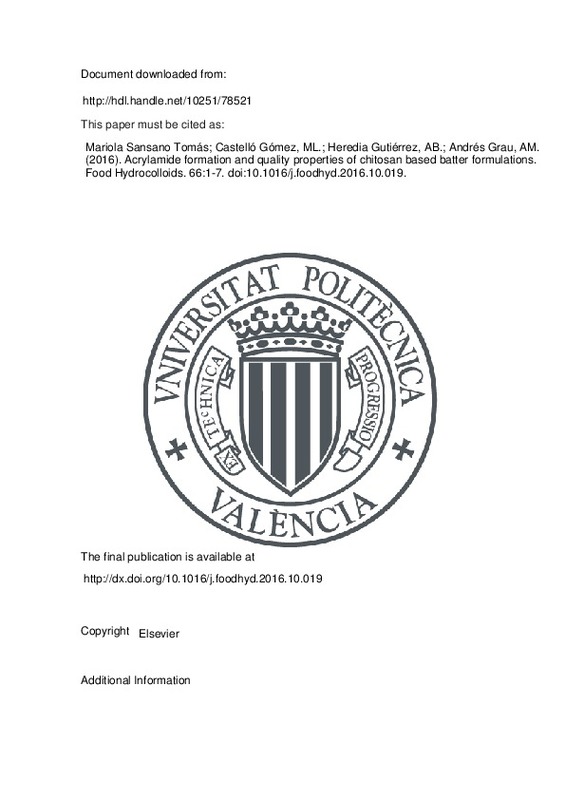JavaScript is disabled for your browser. Some features of this site may not work without it.
Buscar en RiuNet
Listar
Mi cuenta
Estadísticas
Ayuda RiuNet
Admin. UPV
Acrylamide formation and quality properties of chitosan based batter formulations
Mostrar el registro sencillo del ítem
Ficheros en el ítem
| dc.contributor.author | Sansano Tomás, Mariola
|
es_ES |
| dc.contributor.author | Castelló Gómez, María Luisa
|
es_ES |
| dc.contributor.author | Heredia Gutiérrez, Ana Belén
|
es_ES |
| dc.contributor.author | Andrés Grau, Ana María
|
es_ES |
| dc.date.accessioned | 2017-03-06T12:31:53Z | |
| dc.date.available | 2017-03-06T12:31:53Z | |
| dc.date.issued | 2016-10-12 | |
| dc.identifier.issn | 0268-005X | |
| dc.identifier.uri | http://hdl.handle.net/10251/78521 | |
| dc.description.abstract | [EN] The potential of chitosan to mitigate acrylamide formation has been already demonstrated. The two main objectives of this study were: 1) to select the most adequate degree of deacetylation (DD) and molecular weight (Mw) of chitosan based on acrylamide mitigation criteria and 2) to evaluate the influence of including chitosan in batter formulations on some important technological parameters of raw batters (flow behavior and water retention capacity) and on some quality properties of fried batters (oil uptake, color and texture). Results in model systems showed that chitosans with higher deacetylation degree (86.5 and 92.8%) achieved a decrease of acrylamide between 44 and 81%, depending on reaction time, compared to the control (without chitosan). Furthermore, acid hydrolysis process of chitosan was found to negatively affect its inhibitory effect on acrylamide formation independently of the molecular weight. Raw chitosan based batter formulations presented higher consistency and water retention capacity than the control; chitosan addition to batters reduced the hardening of the fried samples during the post-frying cooling period. No significant differences in water loss were observed between batters with or without added chitosan; however, chitosan-batter formulations showed lower oil uptake during frying as compared to control samples. | es_ES |
| dc.description.sponsorship | The authors thank the gs1:Universitat Politecnica de Valencia for the PhD scholarship given to Mariola Sansano Tomas. | en_EN |
| dc.language | Inglés | es_ES |
| dc.publisher | Elsevier | es_ES |
| dc.relation.ispartof | Food Hydrocolloids | es_ES |
| dc.rights | Reconocimiento - No comercial - Sin obra derivada (by-nc-nd) | es_ES |
| dc.subject | Acrylamide | es_ES |
| dc.subject | Chitosan | es_ES |
| dc.subject | Deacetylation degree | es_ES |
| dc.subject | Molecular weight | es_ES |
| dc.subject | Batters | es_ES |
| dc.subject.classification | TECNOLOGIA DE ALIMENTOS | es_ES |
| dc.title | Acrylamide formation and quality properties of chitosan based batter formulations | es_ES |
| dc.type | Artículo | es_ES |
| dc.identifier.doi | 10.1016/j.foodhyd.2016.10.019 | |
| dc.rights.accessRights | Abierto | es_ES |
| dc.contributor.affiliation | Universitat Politècnica de València. Escuela Técnica Superior de Ingeniería Agronómica y del Medio Natural - Escola Tècnica Superior d'Enginyeria Agronòmica i del Medi Natural | es_ES |
| dc.contributor.affiliation | Universitat Politècnica de València. Instituto Universitario de Ingeniería de Alimentos para el Desarrollo - Institut Universitari d'Enginyeria d'Aliments per al Desenvolupament | es_ES |
| dc.description.bibliographicCitation | Sansano Tomás, M.; Castelló Gómez, ML.; Heredia Gutiérrez, AB.; Andrés Grau, AM. (2016). Acrylamide formation and quality properties of chitosan based batter formulations. Food Hydrocolloids. 66:1-7. doi:10.1016/j.foodhyd.2016.10.019 | es_ES |
| dc.description.accrualMethod | S | es_ES |
| dc.relation.publisherversion | http://dx.doi.org/10.1016/j.foodhyd.2016.10.019 | es_ES |
| dc.description.upvformatpinicio | 1 | es_ES |
| dc.description.upvformatpfin | 7 | es_ES |
| dc.type.version | info:eu-repo/semantics/publishedVersion | es_ES |
| dc.description.volume | 66 | es_ES |
| dc.relation.senia | 319294 | es_ES |
| dc.identifier.eissn | 1873-7137 | |
| dc.contributor.funder | Universitat Politècnica de València |








